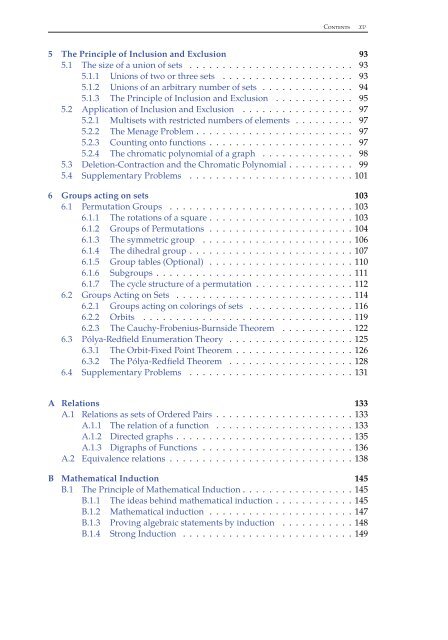Combinatorics Through Guided Discovery, 2004a
Combinatorics Through Guided Discovery, 2004a
Combinatorics Through Guided Discovery, 2004a
Create successful ePaper yourself
Turn your PDF publications into a flip-book with our unique Google optimized e-Paper software.
Contents<br />
xv<br />
5 The Principle of Inclusion and Exclusion 93<br />
5.1 The size of a union of sets ......................... 93<br />
5.1.1 Unions of two or three sets .................... 93<br />
5.1.2 Unions of an arbitrary number of sets .............. 94<br />
5.1.3 The Principle of Inclusion and Exclusion ............ 95<br />
5.2 Application of Inclusion and Exclusion ................. 97<br />
5.2.1 Multisets with restricted numbers of elements ......... 97<br />
5.2.2 The Menage Problem ........................ 97<br />
5.2.3 Counting onto functions ...................... 97<br />
5.2.4 The chromatic polynomial of a graph .............. 98<br />
5.3 Deletion-Contraction and the Chromatic Polynomial .......... 99<br />
5.4 Supplementary Problems .........................101<br />
6 Groups acting on sets 103<br />
6.1 Permutation Groups ............................103<br />
6.1.1 The rotations of a square ......................103<br />
6.1.2 Groups of Permutations ......................104<br />
6.1.3 The symmetric group .......................106<br />
6.1.4 The dihedral group .........................107<br />
6.1.5 Group tables (Optional) ......................110<br />
6.1.6 Subgroups ..............................111<br />
6.1.7 The cycle structure of a permutation ...............112<br />
6.2 Groups Acting on Sets ...........................114<br />
6.2.1 Groups acting on colorings of sets ................116<br />
6.2.2 Orbits ................................119<br />
6.2.3 The Cauchy-Frobenius-Burnside Theorem ...........122<br />
6.3 Pólya-Redfield Enumeration Theory ...................125<br />
6.3.1 The Orbit-Fixed Point Theorem ..................126<br />
6.3.2 The Pólya-Redfield Theorem ...................128<br />
6.4 Supplementary Problems .........................131<br />
A Relations 133<br />
A.1 Relations as sets of Ordered Pairs .....................133<br />
A.1.1 The relation of a function .....................133<br />
A.1.2 Directed graphs ...........................135<br />
A.1.3 Digraphs of Functions .......................136<br />
A.2 Equivalence relations ............................138<br />
B Mathematical Induction 145<br />
B.1 The Principle of Mathematical Induction .................145<br />
B.1.1 The ideas behind mathematical induction ............145<br />
B.1.2 Mathematical induction ......................147<br />
B.1.3 Proving algebraic statements by induction ...........148<br />
B.1.4 Strong Induction ..........................149


















